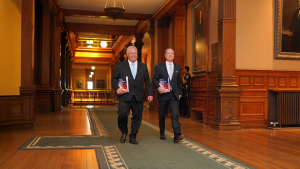In British Columbia, there is no general contractor who knows more about public-private partnerships, or P3s as they’re commonly known, than the province’s largest builder, PCL Westcoast Constructors Inc.
Public-Private Partnerships
In Canada, British Columbia is recognized as the leader when it comes to public-private partnerships or P3s as they’re more commonly known. And in British Columbia there is no general contractor who knows more about them than the province’s largest builder, PCL Westcoast Constructors Inc.
A year ago, PCL completed the new Gordon and Leslie Diamond Ambulatory Centre adjacent to Vancouver General Hospital (VGH).
Right now, PCL is putting the finishing touches on the new $355 million Abbotsford Regional Hospital and Cancer Centre. It is by far the largest building constructed in the province as a P3.
Currently, PCL is competing on two more major provincial P3 projects – a large 500-patient upgrade to the Royal Jubilee Hospital in Victoria and the construction of a totally new outpatient facility in Surrey that will be roughly comparable to the VGH ambulatory care centre. The company didn’t deliberately set out to become so concentrated in the medical field, said Dale Burghall, PCL’s manager of business development.
That just happened to be where the government was spending money when it turned to the public private partnership concept and away from the old traditional bid, build method.
“If they had been financing universities instead I guess we would have been building universities,” he said.
There is no doubt, judging from Burghall’s comments that both the provincial government and the construction industry have been on a learning curve ever since the P3 concept was introduced some four or five years ago.
Originally, the government settled on a European system of partnerships, which sees all three private sector components – the contractor, the financier and the property manager – committed to the project over 30 or 40 years.
This, said Burghall, made no sense for a company such as PCL which is in the business of constructing buildings but doesn’t want to be in the business of operating buildings.
As a result the system has now been refined to the point the contractor is part of the P3 consortium for only the time it takes to build the project plus one year of basic “sea trials”.
The other partners are in for the long haul of managing it.
Recently, starting with the Royal Jubilee project the province made yet another refinement.
The proposal process has been divided into two sections. The first is the submission of contractors’ technical solutions and designs.
The second section, which is submitted about two weeks later, involves the actual finances.
It allows the proponents to get their financial proposals together in a much more orderly and less “panicked” way than is normal in the industry, said Burghall.
The entire P3 evolution has been a learning process, he pointed out.
But, in the end it really boils down to a classic “design build” method as far as the contractor is concerned. And the partnerships involved go through the entire food chain of the project often involving the major trade contractors such as mechanical and electrical.
Quite often large suppliers are part of the partnership as well.
Burghall agreed that this continues the transfer of risk that starts with the general contractor taking on much of the risk of the project from the owner.
The general in turn transfers some risk from his shoulders to his trade contractors and suppliers.
At the same time, said Burghall the trades and the suppliers get much more control over a job and have much more ability to keep it on time and on budget than they normally would have.
This ability to manage balances out the additional risk assumed.
Beyond doubt an important difference between bid/build and P3 is the time frame involved.
Traditionally, contractors had only weeks to get their prices together and reply to a tender call.
With public private partnerships, however, initially more than two years could pass from the time the government requested contractors to submit their qualifications and kicked the process off until the successful proponent was finally selected from a short list.
This time frame, however, is getting shorter as the process becomes more standardized.
On top of that these projects tend to be large so there can easily be another two to three years of construction time.
This all means estimators have to be very, very good at what they do. Obviously prices can move a lot in two or three years as recent industry experience has shown with commodities such as copper.
Burghall has a ready answer for those who criticize the P3 process claiming it is bound to be a more expensive way for government to construct buildings than the traditional bid process.
The government, he points out, will at the end of the day for very little money get at least three very good, very professionally thought out solutions to specific building requirements it has identified.
“Under the traditional system,” he said, “government could spend millions of dollars on the design process before even going out to tender. . .
“We’re in a competitive world and we want to win very much – because it is very painful to lose. There is a lot of money at stake.”
The efficiencies which that type of competitiveness brings out in everybody involved, ensures the government gets top performance for its dollars, he said.
Burghall almost sounds like an NHL coach getting ready for the play-offs.
“It’s a very intense process,” he said. “You have to assign your most experienced people. Although it can be a stressful process it’s an extremely satisfying one – when you win.”











Recent Comments
comments for this post are closed